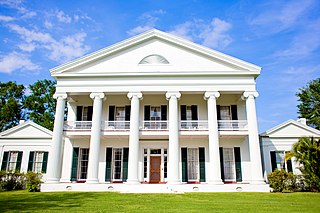
Madewood Plantation House, also known as Madewood, is a former sugarcane plantation house on Bayou Lafourche, near Napoleonville, Louisiana. It is located approximately two miles east of Napoleonville on Louisiana Highway 308. A National Historic Landmark, the 1846 house is architecturally significant as the first major work of Henry Howard, and as one of the finest Greek Revival plantation houses in the American South.

The Magnolia Mound Plantation House is a French Creole house constructed in 1791 near the Mississippi River in Baton Rouge, Louisiana. Many period documents refer to the plantation as Mount Magnolia. The house and several original outbuildings on the grounds of Magnolia Mound Plantation are examples of the vernacular architectural influences of early settlers from France and the West Indies. The complex is owned by the city of Baton Rouge and maintained by its Recreation Commission (BREC). It is located approximately one mile south of downtown.

Evergreen Plantation is a plantation located on the west side of the Mississippi River in St. John the Baptist Parish, near Wallace, Louisiana, and along Louisiana Highway 18. The main house was constructed mostly in 1790, and renovated to its current Greek Revival style in 1832. The plantation's historical commodity crop was sugarcane, cultivated by enslaved African Americans until emancipation.

Oakland Plantation, originally known as the Jean Pierre Emmanuel Prud'homme Plantation, and also known as Bermuda, is a historic plantation in and unincorporated area of Natchitoches Parish, Louisiana. Founded as a forced-labor farm worked by enslaved Black people for White owners, it is one of the nation's best and most intact examples of a French Creole cotton plantation complex. The Oakland Plantation is now owned by the National Park Service as part of the Cane River Creole National Historical Park.

Magnolia Plantation is a former cotton plantation in Natchitoches Parish, Louisiana. The site was declared a National Historic Landmark in 2001, significant as one of the most intact 19th-century plantation complexes in the nation, as it is complete with a suite of slave cabins and numerous outbuildings and period technology. Included in the Cane River Creole National Historical Park, Magnolia Plantation is also a destination on the Louisiana African American Heritage Trail. It is one of two plantations in the park; the other is Oakland Plantation.

The Whitney Plantation Historic District is preserved by the Whitney Institute, a non-profit whose mission is to educate the public about the history and legacies of slavery in the Southern United States. The district, including the main house and outbuildings, is preserved near Wallace, in St. John the Baptist Parish, Louisiana, on the River Road along the Mississippi River. Habitation Haydel was founded in 1752 by Ambroise Heidal, one of the many German immigrants who colonized the river parishes in the 18th century. His descendants owned it until 1860. In 1867 it was sold to businessman Bradish Johnson who renamed it Whitney.

This is a list of the National Register of Historic Places listings in Avoyelles Parish, Louisiana.

The Magnolia Lane Plantation, also known as the Fortier Plantation, is a historic plantation located on the Mississippi River in Jefferson Parish, Louisiana along LA 541. The plantation was owned in 1784 by Edward Fortier, during the Spanish colonial period. After being purchased in 1867 the plantation changed its name.

Audubon State Historic Site is a state park property in West Feliciana Parish, Louisiana, between the towns of St. Francisville and Jackson. It is the location where noted ornithologist and artist John James Audubon spent the summer of 1821.

The St. George Plantation House, in Schriever, Louisiana was added to the National Register of Historic Places in 1982.

Mount Hope Plantation House is a historic plantation house located at 8151 Highland Road in Baton Rouge, Louisiana.

This is a list of the National Register of Historic Places listings in East Carroll Parish, Louisiana.

This is a list of the National Register of Historic Places listings in Winn Parish, Louisiana.

St. Emma Plantation is a 13,000-acre (5,300 ha) former sugar plantation and house in Ascension Parish, Louisiana, United States.

The LaBranche Plantation Dependency House is located in St. Rose, St. Charles Parish, Louisiana. From many accounts, LaBranche Plantation in St. Rose, Louisiana, was one of the grandest on the German Coast until it was destroyed during the American Civil War. All that remained was the dependency house, known as a garconnière.

Chretien Point Plantation is a pre-Civil War twelve room red brick mansion, located on twenty acres on the banks of Bayou Bourbeaux, two miles southwest of Sunset, Louisiana in St. Landry Parish. A Civil War battle was fought on the plantation grounds and Jean Lafitte was a tenant. The mansion was listed on the National Register of Historic Places in 1977.

Frogmore Plantation is an historic, privately owned cotton plantation complex, located near Ferriday in Concordia Parish, Louisiana. Since 1997, Frogmore Plantation is a working farm, tourist attraction featuring many structures, and educational center. Buildings on the site include a cotton gin, and a plantation manor house named Gillespie. Formerly this plantation relied on enslaved African American labor.
The Arlington Plantation is a historic plantation located near Lake Providence, Louisiana. It was listed on the National Register of Historic Places on October 3, 1980.

St. Charles College was a private Jesuit college in Grand Coteau, Louisiana. Founded in 1837 by Jesuits from France and Kentucky, the school was the first Jesuit college established in the American South. It initially educated lay students exclusively until 1890, when it began functioning as a Jesuit scholasticate as well. In 1922, the college closed, and the campus was used only to train Jesuit novices. Today, the campus continues to be used for the training of Jesuits, as well as a retreat center and a home for elderly Jesuits. The surviving structures date to 1909 and are contributing properties of the Grand Coteau Historic District.


















